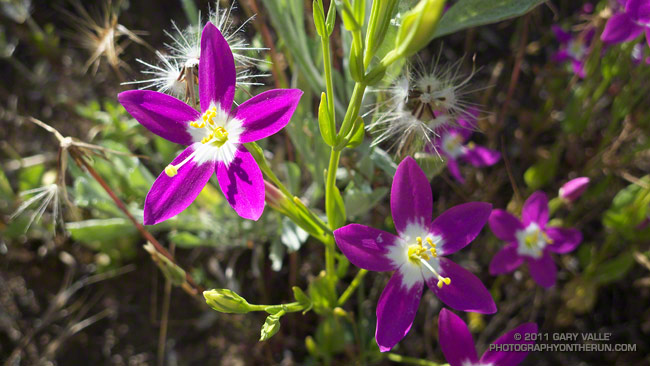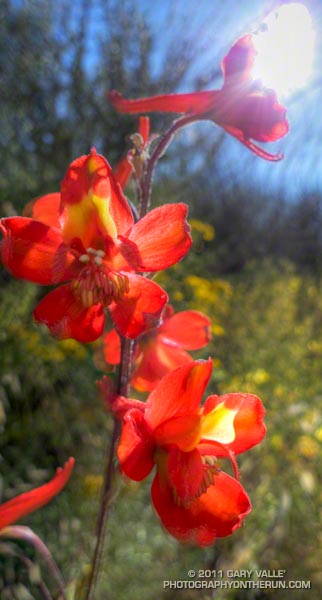
It’s been several weeks now since my bout of contact dermatitis from Poodle-dog bush*. The dermatitis was much better after a week, but took about two weeks to completely go away. I’ve heard this is typical, and several people commented that their Poodle-dog bush experience was similar to mine.
Update July 12, 2011. A running friend who recently did some trail work removing Poodle-dog bush on the Kenyon Devore Trail sent this photograph of a blotchy red rash that developed on his forearm. He first noticed a reaction four days after doing the trail work, and the photograph was taken 10 days after exposure. As in my case, several hours later he commented that the blotchy rash had merged into a more general inflammation with swelling.

The other day I was asked if I’d rather have dermatitis from poison oak or Poodle-dog bush. The reactions are so different, they are hard to compare. Plus, my exposure to Poodle-dog bush was probably a worst case scenario. It was as if the goo from the plant was painted on my arms and legs with a brush, and left to cure. I’m guessing that an equivalent exposure to poison oak would have been much, much worse. The reaction to Poodle-dog bush seems to vary quite a lot from person to person, and some people have been severely affected.
I was a little worried that the extreme exposure to Poodle-dog bush might make me hypersensitive to the plant, but that doesn’t appear to be the case. About a week after recovering from the dermatitis, I did some trailwork with a group that cleared a section of overgrown trail in Shortcut Canyon. Not only was there Poodle-dog bush, but poison oak and stinging nettle as well. With normal precautions — long pants, long sleeves & gloves — I didn’t have a problem.
As long as you don’t have to wade through it, the oceans of violet flowered Poodle-dog bush in the Station Fire burn area are striking. I’ve heard Poodle-dog bush described as an invasive plant. While it is an unbelievably prolific fire-follower that seems to invade an area after a fire, it is a native California plant. Given just how prevalent it is after a fire, it probably plays a key role in the recovery process, perhaps helping to restore the chemical balance of the soil, as well as providing mulch.
*The taxonomic name for Turricula parryi (Poodle-dog bush) has changed to Eriodictyon parryi. The Jepson Manual: Vascular Plants of California, Second Edition (2012) has returned Turricula to the genus Eriodictyon, as originally described by Gray. According to the Wikipedia entry for Turricula (April 11, 2012), “… molecular phylogenetic analysis carried out by Ferguson (1998) confirms that Turricula should be treated as a separate genus within a clade (Ferguson does not use the term “subfamily”) that includes Eriodictyon, and also the genera Nama and Wigandia; Eriodictyon is the genus to which Turricula is closest in molecular terms, and is its sister taxon.” I use “Turricula” and “Poodle-dog bush” interchangeably as a common name.
Related post: After the Station Fire: Contact Dermatitis from Turricula parryi – Poodle-dog Bush and these additional posts.






